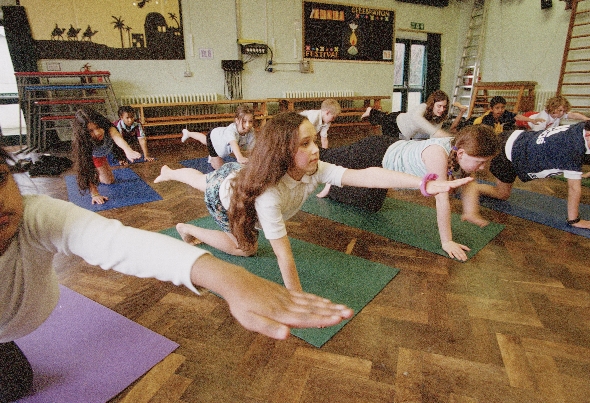 Michael Chissick has been teaching yoga to children in primary mainstream and special needs schools as part of the integrated school day since 1999. He is a primary school teacher as well as a qualified yoga instructor. He is also a specialist in teaching yoga to children with Autism Spectrum Disorders. Michael trains and mentors students who want to teach yoga to children.
Michael Chissick has been teaching yoga to children in primary mainstream and special needs schools as part of the integrated school day since 1999. He is a primary school teacher as well as a qualified yoga instructor. He is also a specialist in teaching yoga to children with Autism Spectrum Disorders. Michael trains and mentors students who want to teach yoga to children.
While the main focus of World Yoga Day is on Human Rights, I thought I would give myself poetic licence to focus also on Children’s Rights – specifically the rights of those children whose behaviour is often labelled ‘disruptive’, because, frankly, it is.
In the following case study from my personal experience as a yoga teacher, you can read how *Sinclair’s behaviour improved significantly because of his success in the yoga lessons over two terms. The plan, to teach challenging postures with aspects of social and emotional learning at the core of the programme, helped change Sinclair’s attitude and behaviour.
*Not his real name.
Is this scenario familiar?
Sinclair was a Year 4 pupil child in a primary school where I was asked to deliver yoga for a year. His class teacher described him as having a low self-image; often being moody, with a short attention span; and often disrupting the class with silly noises or swearing. Sinclair was aggressive to other children and found group work difficult. On the positive side, Sinclair enjoyed Physical Education, loved football, was sharp and incredibly flexible.
My main focus
Whilst I am a specialist children’s yoga teacher, the main focus of my work with children centres on the social and emotional aspects of learning. I teach the whole class and everyone is included. The foremost aim in every lesson is to enhance children’s self-esteem. Other benefits like improved flexibility, fitness, better concentration and calmness, for example, are natural when you practice yoga, yet combined with the emphasis on the aspects of social and emotional learning contribute to a powerful increase in the child’s sense self-worth.

Photo: Michael Chissick’s yoga class students in Tiger Posture (courtesy of Michael Chissick).
Individual Aims for Sinclair
Working with his Class Teacher we decided on the following specific aims:
- Improving Sinclair’s self-esteem
- Encouraging Sinclair to be a role model
- Improving Sinclair’s group communication skills
Our Approach
Our approach was to cultivate and build on the following three positive aspects:
- Sinclair the demonstrator
- Sinclair the ‘helpful teacher’
- Sinclair the ‘star’ at school and at home
Sinclair the demonstrator
Sinclair was a natural yogi and we quickly realised that he was excelling at the posture work. We decided to use Sinclair as much as fairly possible to demonstrate new postures and reinforce old ones to the whole class. Before the lesson, the class teacher would remind Sinclair that he was being given the responsibility of showing the other children postures and it meant that he had to show responsible behaviour too.
Sinclair the ‘helpful teacher’
Group work was an essential ingredient of the lesson in achieving our aims. The children worked in groups of six. Each group was to work as a team to find a way to perform a specific posture in an interesting way that also supported and connected with each other.
We made it clear that we were looking to reward group skills which included listening and making decisions. Above all there was an emphasis on group members helping each other in a kind and encouraging way. In other words, children were given the responsibility of looking out for each other.
Sinclair’s expertise at the postures set him up as a natural leader and his attention to detail meant that he could spot ways to help children in his group.
We had given him some input on how to get his classmates to change an aspect of the posture in an encouraging way, and Sinclair learnt and applied these skills with ease and a gentleness that his teacher had not seen before. Sinclair was also very keen to be the group spokesperson, yet gradually, over time, he more readily agreed to let someone else have a turn.
Sinclair the ‘Star’ at school and at home
Sinclair performed the most challenging postures to the whole school at two achievement assemblies, where he was encouraged to explain how yoga had helped him to be calmer and more focused. We also discovered that his family eagerly awaited his return from school on yoga day when he would teach them new postures and play yoga games with his two brothers.
Certificates and stickers
Sinclair worked hard to get the special certificates that were awarded to children who could show:
- Good listening skills to teachers and children
- How to help other children in group work
- Improved behaviour
He also earned his fair share of stickers for good listening, learning to be still in calming postures and games and relaxation, as well as increasing concentration and being well-mannered.
Summary
The combination of our behavioural approach and the yoga improved Sinclair’s self-esteem and consequently improved his behaviour because:
- he experienced a great sense of success in the yoga.
- the calming and relaxation aspects of the lesson gave him experiences that helped him feel in control.
- he was perceived as an expert by his class and earned their respect
- he tried hard to overcome his disruptive behaviours in order to win the special certificates and stickers that were an incentive for him to change.
- Sinclair’s parents were able to celebrate his success at home and give lots of genuine praise.
- the combined effect of rewards and praise from me, the class teacher, peers and parents had a very powerful and positive effect on Sinclair’s self-esteem.
Conclusion
This case study is yet another example that supports the case for yoga to be taught in schools as part of the integrated school day on an ongoing basis. Clearly, it also shows the importance of placing the social and emotional aspects of learning at the core of the yoga lesson.
If there is one message I hope teachers and parents take away on World Yoga Day, it’s that yoga can help children foster a sense of achievement regardless of stature, academic ability, upbringing and other differences.
Read a Preview of Frog’s Breathtaking Speech »
This post was adapted with permission from Yoga at School. Visit www.yogaatschool.org.uk for more info.